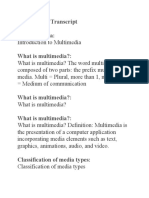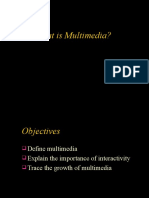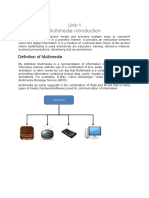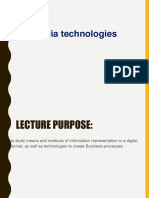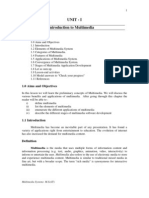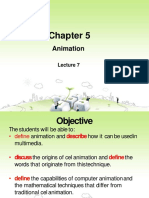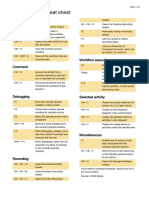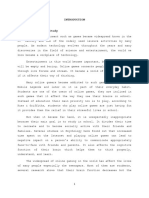Introduction
to Multimedia
Dr. Mohammed Shobail
What is multimedia?
• The word multimedia is composed of two parts: the prefix multi
and media.
• Multi = Plural, more than 1, many
• Media = Medium of communication
1
� What is multimedia?
What is multimedia?
Definition:
Multimedia is the presentation of a computer application
incorporating media elements such as text, graphics, animations, audio, and video.
2
�Classification of media types
Time/Space nature
Sound Video Animation
Continuous
or time-based
Photo Text Graphics
Discrete
or space-based
Origin
Captured Synthesized
from real world by computer
Captured Versus Synthesized Media
• Captured media refers to information types captured from the
real world (e.g. Still pictures, moving pictures, and sound).
• Synthesized media refers to information types synthesized by the
computers (e.g. Text, graphics and computer animation).
3
�Discrete Versus Continuous Media
• Discrete media refers to media involving space dimension only
(e.g. Still images, text and graphics). Discrete media is also
referred to as static media or non-time-based media or non-
temporal media or space-based media.
• Continuous (time based) media refers to time-based media
(e.g. Sound, moving images, and animation). Continuous media
is also referred to as dynamic media or time-based media or
temporal media.
Multi-sensory system
• According to Dr. Albert Mehrabian, a specialist in interpersonal
communication at the University of California, says:
People recall 20% of what they see
40% of what they see & hear
70% of what they see, hear & do
• Multimedia allows for seeing, hearing and doing (multi-sensory
system)
4
� Characteristics of Multimedia System
1. They must be computer-controlled.
User is able to view, hear, and see using a Multimedia
PC System.
2. They are integrated.
At least one discrete and one continuous media
combined for information presentation and sharing.
…continued
3. The information they handle must be represented
digitally.
Consists of various form of media i.e. text, graphics,
audio, video, and animations; created, stored, processed,
and transmitted DIGITALLY.
4. The interface to the final user may permit interactivity.
User is able to navigate, interact, create, and
communicate.
5
� Benefits of using multimedia in software
• Ease of use
- User friendly, increase user’s effectiveness
• Intuitive Interface
- Allows user to determine functions of an application by their
own intuition
• Immersive Experience
- Software application takes over the entire computer screen,
allows user to focus on application
Benefits of using multimedia in software
• Self-paced interaction & better retention
- allows information processing at one’s own pace
• Better understanding
- simultaneous presentation of different media provides richer &
broader range of information.
• Cost effectiveness
- less training, less technical support
6
�Problems with Multimedia
• Investment costs
- multimedia involves high volume of content
- expensive copyright and royalty
• Technical barriers (accessibility issues)
- upgrade IT & PC infrastructure
• Social Psycho logical barriers
- Generation gap
- Learning rates
- Learning in group/individual
- Importance of teacher
• Legal problems
- Copyright
Where to use multimedia ?
• Business
• Government
• Education
• Broadcasting & Entertainment
• Health
7
�Business
Interactive Multimedia Merchandising
• Online-shopping Kiosks
• Virtual shopping / home shopping
http://www.thevirtualmall.co.uk/
Desktop Videoconferencing
• Due to the high cost of transportation and the large amount of
employee time spent traveling to meetings, videoconferencing is
on the rise.
…continued
Multimedia Travel Systems
• These systems enable the travel agents to show their customers
about where they will travel, what will be their accommodation
like, and what they will be able to do at their destinations.
www.visitmalaysia.com.my
Real Estate
• Multimedia systems enable buyers to visit hundreds of properties
virtually, view on screen photos of homes, inspect floor plans, see
street maps, and study neighborhood demographics.
www.penangtimessquare.com
8
�…continued
Corporate Training
• Many corporations have used multimedia to reduce training cost
and improve employee productivity.
Advertising and Electronics Brochures
• The electronic brochure is an advertising and marketing tool that
usually consists of single diskette or CD-ROM sent to targeted
audiences. Corporations are also beginning to offer shareholders
annual reports on CD-ROM.
www.porsche.com
Government
Public Service Kiosks
• Multimedia kiosks convey public service information such as jobs
and employment opportunities.
• City-info kiosks offer to citizens and travelers the ability to find
information on addresses, points of interest, shops, restaurants,
public transportation, hours of opening, guided tours, city
transport info.
9
� …continued
Politics
• Multimedia in general and internet in particular are playing a big role in
politics and virtual campaigning where every political candidate contesting
in an election has a web site.
Consumer Information
• Multimedia based CD-ROMs are available which
contains government information on a wide variety of
topics: government forms, list of government offices in
each state, tax preparation etc.
Education
Computer Aided Learning
• To assist student through simulation for better
understanding such as volcano eruption,
corrosion, language pronunciation, etc.
www.quiz-tree.com
Virtual Campus
• Learning takes place in a virtual classroom using
video conferencing and online lecture so that
students all around the world can attend.
10
�Broadcasting and Entertainment
Electronic catalogue
• Product features and descriptions are advertised through web, CD
and mobile devices.
• Interactive Movie
• Viewers can decide the direction of the plot of the movie and
camera angle.
On-demand News or movies
• News, movies and TV series can be watched on demand through
web and mobile devices.
http://soccernet.espn.go.com
…continued
3D or animated movies
• Movies created through advance 3D
technology and animation techniques.
Video Games
• Advances in the field of multimedia have
led to more attractive video and computer
games being available now in the
consumer market.
11
�…continued
Virtual Reality
• Virtual Reality refers to the use of a computer
to immerse the user into a simulated
experience that it seems real. Virtual reality
systems often use special hardware to
enhance the experience, including visual
displays.
Cyber Sports
• Cyber Sports is the use of virtual reality to provide computer users
with a realistic sports experience. Two new interactive virtual reality
devices let you “Swing” and “Hit” balls at your PC.
Medicine
Virtual Surgery
• Virtual surgery authoring system has been created for producing
surgical training simulation.
• Surgeons can use 3-D images created from magnetic resonance
imaging (MRI) scans of the human body to practice complicated
procedures such as brain tumor removal and reconstructive surgery.
12
�…continued
Video Conferencing and Image Retrieval
• The use of imaging techniques (X-Rays, CT, MRI etc) is growing in
health care. The collection, maintenance, processing and
distribution of these records can be significantly improved by using
computer based storage and multimedia networking. Once these
records are integrated with the on-line patient information and easily
shared by both local and remote physicians, it results in a large
number of benefits like reduced cost and improved care.
Multimedia Products
• Briefing
eg: corporate presentation, sales presentation and educational lectur
es.
• Reference
eg: encyclopedias, dictionaries
• Database
eg: library system, phone directory
13
�…continued
• Education and Training
eg: - Instructor support products – Resource materials
for instructors
- Standalone or self-paced products – Learning
materials for students
to study at their own
pace
• Kiosk
eg: bank machines, mall information centers.
• Entertainment and Games
eg: computer games and movies.
Evaluating Multimedia Products
• Evaluation can be done from two perspectives:
User’s Perspective Developer’s Perspective
• Subject and Content • Content
• Platform • Performance
• Usability • Delivery
• Cost • Interface
14
�User’s perspective
Subject/content
Area of interest
Entertainment value – multimedia games and sports-related
products
Education, training or learning objectives – how-to and subject-
related products
Need for information – encyclopedia or similar reference products
…continued
Platform (hardware and software)
Focus on what type of equipment the user has and if it is compatible
with a specific product.
Criteria for evaluation:
Hardware platforms
Computer processor speed and data bus requirements
Memory sizing
15
�…continued
Usability
• Usability means that the user can apply, learn, use the program
efficiently.
• The key criteria here are:
Learning/training time: how long does it take to learn how to use
the product,
Error rate: how often mistakes made by the users and how severe
is the mistake?,
Task Time: how long does it take to accomplish a task,
Retention: how difficult is for the user to operate and how
attractive is the product to use.
…continued
Cost
• The cost can be the first or the last factor considered by many
people. Generally, users are willing to spend depending on how
much is gained.
16
�Developer’s perspective
• Developer must evaluate and aim to improve their product better th
an the last.
• From the developer’s perspective, evaluation will cover:
- Content
- Performance
- Delivery
- Interface
Developer’s perspective
Content
• Product domain or subject matter- is the material useful for the end use
r?
• Message – How does the product communicate the information? Will t
he users understand it?
• Comparison to comparable products
17
�…continued
Performance
• Developer must consider that general users have equipment that
has much less capabilities, so products should always be tested on a
range of platforms before they are released.
• Graphic, audio and video presentation should be use wisely not to
slow down the application for slower machine.
…continued
Delivery
• Delivery means how fast user is able to use the product depending
on the speed of the installation procedure, the configuration and
documentation.
• The instructions should be straightforward, easy to configure and
documentation are thorough and adequate.
18
�…continued
Interface
Ease-of-use for novice users
Depth for experienced or expert users
Navigation features all work and are all useful and user-friendly
Enabling Technologies
• The main reason for increasing popularity of multimedia lies in
dramatic concurrent advances in some enabling technologies
Higher processing power
More memory capacity
Bigger storage capacity
Better compression technology
Carrier and transmission technology
Input and output device technology
Protocol technology
Database technology
Software technology
19
�20

